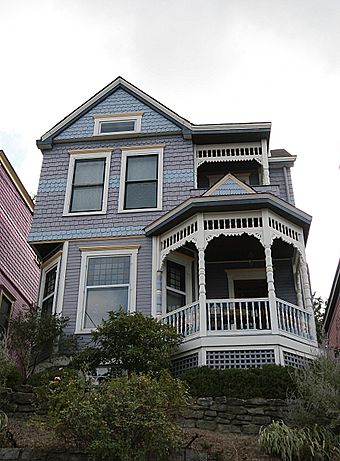Norwell Residence facts for kids
Quick facts for kids |
|
|
Norwell Residence
|
|

Front of the house
|
|
| Location | 506 Tusculum Ave., Cincinnati, Ohio |
|---|---|
| Area | Less than 1 acre (0.40 ha) |
| Built | 1890 |
| Architectural style | Late Victorian |
| MPS | Columbia-Tusculum MRA |
| NRHP reference No. | 79002707 |
| Added to NRHP | August 24, 1979 |
The Norwell Residence is a special old house located in the Columbia-Tusculum area of Cincinnati, Ohio, in the United States. It's a great example of Victorian architecture, built way back in 1890. This house is made of wood siding, called weatherboarding, and sits on a strong stone foundation with a shingled roof.
What Makes the Norwell Residence Unique?
The house has a really interesting shape. It looks like the letter "L" from above, but it seems like a normal rectangle because of two porches that fill in the empty space. It's two and a half stories tall, which means it has two full floors and a smaller half-floor, usually in the attic.
A Closer Look at its Design
The Norwell Residence is full of fancy details that make it stand out. On one side, you can see special overlapping shingles that look like fish scales. The main porch has a decorative band, called a frieze, with cool wooden spindles. These spindles are like small, carved posts. The porch also has small, cleverly designed supports.
Even more unique is the second porch, which sits right on top of the main one! It has similar supports and spindles, making the house look even more grand and detailed.
Why is it Special?
The Norwell Residence is very important because its design hasn't changed much since it was built. In 1978, experts studying old buildings in Columbia-Tusculum called it "outstanding." This house also influenced other homes nearby. Eight other houses in the area were built to look similar to the Norwell Residence.
Because of its amazing architecture, the Norwell Residence was added to the National Register of Historic Places in 1979. This is a list of places in the United States that are important to history or architecture. It was one of seventeen properties in Columbia-Tusculum added to this list at the same time. Most of these were buildings, but two old cemeteries, the Columbia Baptist and Fulton-Presbyterian Cemeteries, were also included.



